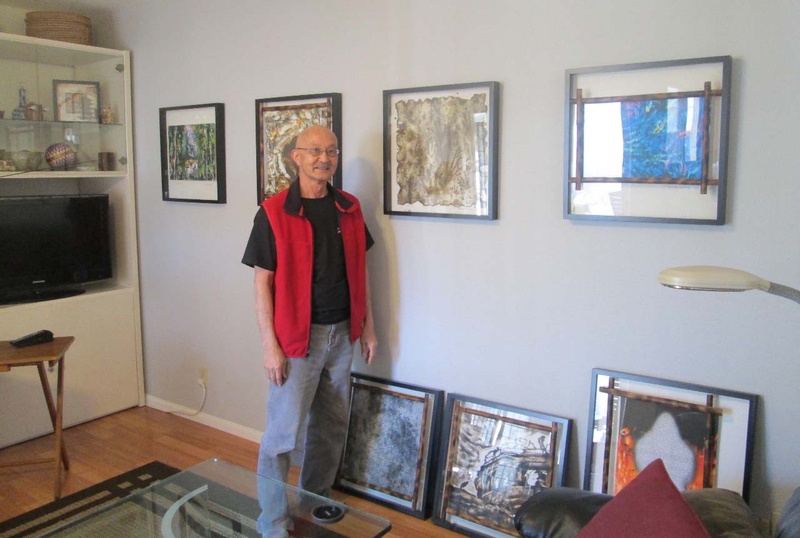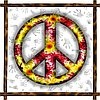Read Part 1 >>
Passing on History
On artist Richard Fukuhara’s business card, 18th century political theorist and philosopher Edmond Burke’s famous phrase is written: “Those who don’t know history are destined to repeat it.” This phrase summarizes the reason why Richard created “Shadows For Peace: For the Sake of the Children.” Richard hopes that by conveying the horrors that the victims of the atomic bomb in Hiroshima and Nagasaki experienced through his artwork that one day, there will be a more peaceful world. His series based on this project will be on display on March 21, 2015 at the Japanese American National Museum. 2015 is also the 70th anniversary of the atomic bomb being dropped on Hiroshima and Nagasaki.
The first time that Richard visited the Hiroshima Peace Memorial Museum was in the 1970s. “It was a long time ago, but it left a deep impression on me.”
When Richard came into contact with images of children that had their future and hope taken away in a blink of an eye, countless people that died in pain and anguish, and mounds of bodies that piled in a river after they jumped in to cool down their burnt bodies, he began creating his art pieces with an overwhelming sense of destiny. He thought to himself, “This can never happen again. And this story has to be told, so that it’ll never be forgotten.”
“I’m not trying to air grievances about the ills of the United States government or the Japanese government. I created these pieces, because I believe, as a human being, this should never happen again.”
He captures the images of the suffering faces in and around the warped Atomic Bomb Dome, the shadows of victims with flames burning in the background, the severely burnt hands of countless people that reach out for help in pouring black rain, and the backs of school-age children that are walking toward the Heiwakinenzō (Peace Memorial Statue) in Nagasaki surrounded by bamboo brushes. “I took a picture of the Heiwakinenzō in Nagasaki, the kids in Hiroshima, and the bamboo in Pasadena,” says Richard. His pieces are quite unique and creative.
He tells us that he drew his inspiration by going to Hiroshima, Nagasaki, and the Peace Memorial Museums countless times to create these pieces. “When I was planning a gallery show in Nagoya, I stayed there only for an hour, had lunch with the Nagoya International Director and staff, then headed off to Hiroshima and Nagasaki for two days in each to take photos and come up with ideas for this piece. During other visits to the cities I would spend hours in the Peace Parks sitting, observing, meditating, sleeping, and feeling the spirits of the victims.” For Richard, it’s his lifelong passion to create pieces that tell the story of Hiroshima and Nagasaki.
For the Sake of the Children
His artwork is framed in burnt bamboo. He explained to me that bamboo is a symbol of Asia, and states, “It’s strong and malleable. It goes back even if it’s bent.” Richard has childhood memories of the struggles Japanese and Japanese Americans had after the war that reflects from the sub-title of this series, “For the Sake of the Children.” “The gardener friends that hung around my father’s nursery would say, ‘for the sake of the children (kodomo no tame ni),’ when someone would comment on the difficult times. From that I gathered that they could go through any kind of hardship for their children.” Parents and adults are supposed to work tirelessly for the future of the children. But in order for that to happen, there needs to be peace in the rest of society.
When I listened to Richard talk about his involvement in six different projects, I couldn’t believe that one man could do so much by himself. When I asked him where all his energy comes from, he answered: “I love people. And I love to tell stories. That’s all.”
He shared with me a story like this, too. “When Mayor Fukuda, from Iwakuni City, Yamaguchi, came to the United States to celebrate the 50th anniversary of Everett, Washington, being sister cities, he contacted me through his office saying that he wanted to come to Los Angeles to visit the members of the Yamaguchi Kenjinkai. So, we decided to host a dinner party for him. Since Mayor Fukuda was staying in Little Tokyo, we decided to take him to the Japanese American National Museum across the street. When Mayor Fukuda learned about the history of Japanese Americans in the internment camps for the first time, I could see that he was deeply moved.”
There are too many Japanese people in Japan that don’t know the experiences of the Japanese Americans in the internment camps. As for myself, being born and raised in Japan, I learned about the experiences of Japanese Americans for the first time as an adult after I watched the movie Come See the Paradise by Alan Parker. “Knowing” is the key to not repeating the horrors of the past, and in order to do that, people are necessary to “pass on” that history. Through his artwork and his various community service projects, Richard continues to pass on history to the next generation. To a future that is free from war and nuclear destruction—for a world where parents can raise their children in peace. This is all for the sake of the children.
* * * * *
*JANM and the Orange Coast Optimist Club will be hosting a forum, “Shadows for Peace for the Sake of the Children (Kodomo no Tame Ni): The Hiroshima and Nagasaki Experience” on Saturday, March 21, 2 p.m. at the Japanese American National Museum. The event will address the devastating and ongoing effects of atomic weapons on the people of Japan and the world. A range of internationally recognized speakers will discuss the legacy of the nuclear age and present video interviews with hibakusha (atomic bomb survivors). Doug Erber, President of the Japan America Society of Southern California, will serve as emcee.
© 2015 Keiko Fukuda








